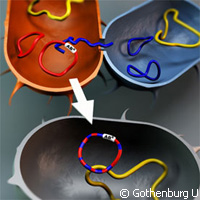Bacteria and antibiotic resistance: the role of IncP-1 plasmids
Scientists in Sweden have discovered that the part of bacterial deoxyribonucleic acid (DNA) that frequently carries antibiotic resistance has the capacity to move between several types of bacteria and adapt to widely differing bacterial species. The findings, which are presented in the journal Nature Communications, shed light on how IncP-1 plasmids can boost the potential for gene spreading. Medical advances are providing more and better treatment for people who need it. But an increasing number of bacteria are also becoming resistant to our common antibiotics. Adding to this problem is the fact that more and more such bacteria are becoming resistant to all antibiotics available on the market. Experts call this problem 'multi-resistance'. They consider multi-resistance as being one of the most major future threats to public health. Resistance to antibiotics can emerge in bacteria found in both our bodies and the environment, and can then be transferred to the bacteria that trigger diseases in people. This can occur regardless if the bacteria are related or not to each other. Researchers from the University of Gothenburg and Chalmers University of Technology point out that conjugative plasmids, which contain tra genes, perform the complex process of conjugation, the transfer of plasmids to another bacterium. Conjugative plasmids are a part of the bacterial DNA, and plasmids can only exist and multiply within cells. These plasmids use the cell's machinery and can then move to another cell. The result is the spread of bacteria. The team used advanced DNA analysis to investigate IncP-1 plasmids, a group of the known carriers of antibiotic resistance genes. They mapped the origin of various IncP-1 plasmids and their mobility among different bacterial species. 'Our results show that plasmids from the IncP-1 group have existed in, and adapted to, widely differing bacteria,' explains Peter Norberg from the Institute of Biomedicine at the University of Gothenburg, the lead author of the study. 'They have also recombined, which means that a single plasmid can be regarded as a composite jigsaw puzzle of genes, each of which has adapted to different bacterial species.' Not only does this show very good adaptability, but it also suggests that these plasmids can move relatively freely among, and flourish in, widely differing bacterial species. Commenting on the role of IncP-1, Professor Malte Hermansson from Gothenburg's Department of Cell and Molecular Biology says: 'IncP-1 plasmids are very potent 'vehicles' for transporting antibiotic resistance genes between bacterial species. Therefore, it does not matter much in what environment, in what part of the world, or in what bacterial species antibiotic resistance arises. Resistance genes could relatively easily be transported from the original environment to bacteria that infect humans, through IncP-1 plasmids, or other plasmids with similar properties, as 'vehicles'.'For more information, please visit: University of Gothenburghttp://www.gu.se/englishNature Communicationshttp://www.nature.com/ncomms/index.html
Countries
Sweden



